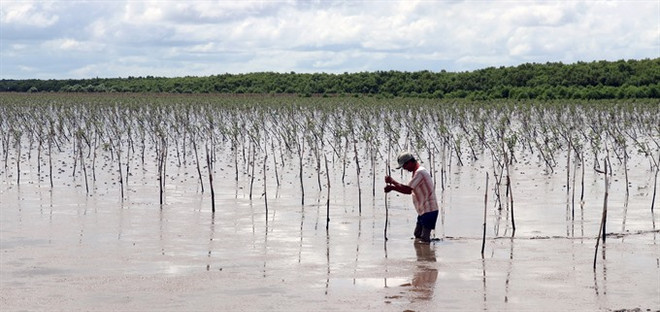 A farmer plants mangrove trees in Nam Thai commune, An Bien district, the southern province of Kien Giang. (Photo: VNA)
A farmer plants mangrove trees in Nam Thai commune, An Bien district, the southern province of Kien Giang. (Photo: VNA)Kien Giang (VNS/VNA) - Localhouseholds assigned to plant mangrove trees and breed aquatic species inforested areas are earning higher incomes in two coastal districts of KienGiang province.
The families were allocated a certain area offorest to protect under a provincial programme.
The submerged forests in the coastal areas of AnBien and An Minh districts have a length of 60km and cover more than 4,000ha.Of the figure, nearly 3,000ha have been allocated to 867 households. The restare protected by the An Bien – An Minh Forest Management Board.
The submerged forests, which run from An Bien’s TayYen commune to An Minh’s Van Khanh Tay commune, are divided into one mainforest belt and a secondary forest belt.
The secondary forest belt in which most “duoc” (rhizophoraapiculata) trees are planted have been allocated to local households forprotection.
Since 2011, the board has assigned localhouseholds to protect submerged forests, plant new forests and breed aquaticspecies.
Under the policy, forest-allocated households areallowed to use 70 percent of forest land to plant trees and 30 per cent tobreed aquatic species such as fish, shrimp, crab and blood cockles.
The breeding of aquatic species in the forests hashelped many poor households escape poverty, according to the management board.
Van Kin, who has protected 15ha of submergedforests in An Minh’s Thuan Hoa commune, said besides planting mangrove trees,he breeds blood cockles, shrimp and crab in his forested area. He earnsan income of 150-200 million VND (6,600–8,800 USD) a year, mostly fromharvesting blood cockles, he said.
In the next few years, his family will haveadditional income when mangrove trees are harvested, he said.
Tran Phi Hai, director of the management board,said that submerged forests have recovered after being allocated to households.
Nguyen Van Khoe, who protects 12ha of submergedforests in An Minh’s Nam Thai A commune, said his seven-year-old mangroveforests are well-protected. “My forests look like primitive forests and arebeautiful,” he said.
In his forests, he breeds blood cockles as thisbivalve mollusc offers higher profits than shrimp or crab, he said.
Every year, he earns a profit of 400-500 millionVND (17,600–22,000 USD) from breeding blood cockles, he said.
“Most households here have become much better-offfrom breeding blood cockles and planting submerged forests,” he said.
Blood cockles from these areas are well-known fortheir good flavour.-VNS/VNA




























